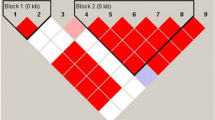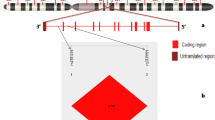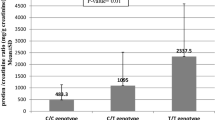Abstract
Systemic lupus erythematosus (SLE) is a complex multisystem autoimmune disease afflicting more than 600,000 individuals in China. RANTES (regulated on activation, normal T cell expressed and secreted, 17q11.2-q12) is a member of the proinflammatory cytokine family known as “chemokines”. It plays an important role in the attraction and recruitment of lymphocytes, monocytes and eosinophils to sites of inflammation. A total of 146 SLE patients and 159 random healthy volunteer individuals in Han Chinese patients were enrolled in this study. Genotypes of RANTES −403 locus and −28 locus were observed to be different in all racial groups. The frequency of individuals who possessed G allele at −28 locus among SLE patients was not significantly different from that among normal controls. A total of seven compound genotypes at −403 locus and −28 locus were observed in this study. The frequency of this compound genotype (−403 G/G, −28 C/C) was different between the two groups. The distribution of genotypes and alleles at RANTES-403 locus was observed to be significantly different between renal damaged group and no renal damaged group (P<0.05), while there was no significant difference in distribution of genotypes and alleles at RANTES-28 locus between the two groups. These results suggest that (a) two genetic polymorphisms in the RANTES promoter do not correlate with SLE as individual polymorphisms. (b) interaction of the polymorphisms at two loci probably exerts a risk effect against SLE and (c) polymorphism at RANTES-403 locus is probably related with renal damage.
Similar content being viewed by others
References
Kotzin BL, Kozora E (2001) Anti-DNA meets NMDA in neuropsychiatric lupus. Nat Med 7(11):1175–1176
Dongqing Ye (2001) Dermatosis epidemiology. The people health publishing house, Beijing, pp 480–487
Grennan DM, Parfitt A, Manolios N, Huang Q, Hyland V, Dunckley H, Doran T, Gatenby P, Badcock C (1997) Family and twin studies in systemic lupus erythematosus. Dis Markers 13(2):93–98
Shai R, Quismorio FP Jr, Li L et al (1999) Genome-wide screen for systemic lupus erythematosus susceptibility genes in multiplex families. Hum Mol Genet 8(4):639–644
Bengtsson AA, Rylander L, Hagmar L, Kwon OJ, Morrison J, Wallace DJ, Neuwelt CM, Brautbar C, Gauderman WJ, Jacob CO (2002) Risk factors for developing systemic lupus erythematosus: a case-control study in southern Sweden. Rheumatology (Oxford) (5):563–571
Olson JM, Song Y, Dudek DM, Moser KL, Kelly JA, Bruner GR, Downing KJ, Berry CK, James JA, Harley JB (2002) A genome screen of systemic lupus erythematosus using affected-relative-pair linkage analysis with covariates demonstrates genetic heterogeneity. Genes Immun 3(s1):S5–S12
Lindqvist AK, Steinsson K, Johanneson B, Kristjansdottir H, Arnasson A, Grondal G, Jonasson I, Magnusson V, Sturfelt G, Truedsson L, Svenungsson E, Lundberg I, Terwilliger JD, Gyllensten UB, Alarcon-Riquelme ME (2000) A susceptibility locus for human systemic lupus erythematosus (hSLE1) on chromosome 2q. J Autoimmun 14(2):169–178
Magnusson V, Lindqvist AK, Castillejo-Lopez C, Kristjansdottir H, Steinsson K, Grondal G, Sturfelt G, Truedsson L, Svenungsson E, Lundberg I, Gunnarsson I, Bolstad AI, Haga HJ, Jonsson R, Klareskog L, Alcocer-Varela J, Alarcon-Segovia D, Terwilliger JD, Gyllensten UB, Alarcon-Riquelme ME (2000) Fine mapping of the SLEB2 locus involved in susceptibility to systemic lupus erythematosus. Genomics 70(3):307–314
Gaffney PM, Kearns GM, Shark KB, Ortmann WA, Selby SA, Malmgren ML, Rohlf KE, Ockenden TC, Messner RP, King RA, Rich SS, Behrens TW (1998) A genome-wide search for susceptibility genes in human systemic lupus erythematosus sib-pair families. Proc Natl Acad Sci USA 95(25):14875–14879
Gaffney PM, Ortmann WA, Selby SA, Shark KB, Ockenden TC, Rohlf KE, Walgrave NL, Boyum WP, Malmgren ML, Miller ME, Kearns GM, Messner RP, King RA, Rich SS, Behrens TW (2000) Genome screening in human systemic lupus erythematosus: results from a second Minnesota cohort and combined analysis of 187 sib-pair families. Am J Hum Genet 66(2):547–556
Lindqvist AK, Alarcon-Riquelme ME (1999) The genetics of systemic lupus erythematosus. Scand J Immunol 50(6):562–571
Maddison P, Farewell V, Isenberg D, Aranow C, Bae SC, Barr S, Buyon J, Fortin P, Ginzler E, Gladman D, Hanly J, Manzi S, Nived O, Petri M, Ramsey-Goldman R, Sturfelt G (2002) Systemic Lupus International Collaborating Clinics. The rate and pattern of organ damage in late onset systemic lupus erythematosus. J Rheumatol 29(5):913–917
Hashimoto H, Nishimura Y, Dong RP, Kimura A, Sasazuki T, Yamanaka K, Tokano Y, Murashima A, Kabasawa K, Hirose S (1994) HLA antigens in Japanese patients with systemic lupus erythematosus. Scand J Rheumatol 23(4):191–196
Koene HR, Kleijer M, Swaak AJ, Sullivan KE, Bijl M, Petri MA, Kallenberg CG, Roos D, von dem Borne AE, de Haas M (1998) The Fc gammaRbA-158F allele is a risk factor for systemic lupus erythematosus. Arthritis Rheum 41(10):1813–1818
Zuniga R, Ng S, Peterson MG, Reveille JD, Baethge BA, Alarcon GS, Salmon JE (2001) Low-binding alleles of Fcgamma receptor types aA and bA are inherited independently and are associated with systemic lupus erythematosus in Hispanic patients. Arthritis Rheum 44(2):361–367
Morita C, Horiuchi T, Tsukamoto H, Hatta N, Kikuchi Y, Arinobu Y, Otsuka T, Sawabe T, Harashima S, Nagasawa K, Niho Y (2001) Association of tumor necrosis factor receptor type a polymorphism 196R with systemic lupus erythematosus in the Japanese. Molecular and functional analysis. Arthritis Rheum 44(12):2819–2827
Gibson AW, Edberg JC, Wu J, Westendorp RG, Huizinga TW, Kimberly RP (2001) Novel single nucleotide polymorphisms in the distal IL-10 promotor affect IL-10 production and enhance the risk of systemic lupus erythematosus. J Immunol 166(6):15–22
Mehrian R, Quismorio FP Jr, Strassmann G, Stimmler MM, Horwitz DA, Kitridou RC, Gauderman WJ, Morrison J, Brautbar C, Jacob CO (1998) Synergistic effect between IL-10 and bcl-2 genotypes in determining susceptibility to systemic lupus erythematosus. Arthritis Rheum 41(4):596–602
Horiuchi T, Nishizaka H, Yasunaga S, Higuchi M, Tsukamoto H, Hayashi K, Nagasawa K (1999) Association of Fas/APO-1 gene polymorphism with systemic lupus erythematosus in Japanese. Rheumatology 38(6):516–520
Baggiolini M (1998) Chemokines and leukocyte traffic. Nature 392(6676):565–568
Hsieh SC, Yu HS, Lin WW, Sun KH, Tsai CY, Huang DF, Tsai YY, Yu CL (2003) Anti-SSB/La is one of the antineutrophil autoantibodies responsible for neutropenia and functional impairment of polymorphonuclear neutrophils in patients with systemic lupus erythematosus. Clin Exp Immunol 131(3):506–516
Kim HL, Lee DS, Yang SH (2002) The polymorphism of monocyte chemoattractant protein-1 is associated with the renal disease of SLE. Am J Kidney Dis 40(6):1146–1152
Chen S, Liu Z, Chen H, Zhou H, Wang J, Li L (2002) Glomerular chemokine expression and the effect of steroid and cyclophosphamide pulse therapy in human crescentic glomerulonephritis. Chin Med J (Engl) 115(9):1301–1307
Mancardi S, Vecile E, Dusetti N, Calvo E, Stanta G, Burrone OR, Dobrina A (2003) Evidence of CXC, CC and C chemokine production by lymphatic endothelial cells. Immunology 108(4):523–523
Aoki M, Pawankar R, Niimi Y, Kawana S (2003) Mast cells in basal cell carcinoma express VEGF, IL-8 and RANTES. Int Arch Allergy Immunol 130(3):216–223
Dorner BG, Steinbach S, Huser MB, Kroczek RA, Scheffold A (2003) Single-cell analysis of the murine chemokines MIP-1alpha, MIP-1beta, RANTES and ATAC/lymphotactin by flow cytometry. J Immunol Methods 274(1–2):83–91
Nelson PJ, Kim HT, Manning WC, Goralski TJ, Krensky AM (1993) Genomic organization and transcriptional regulation of the RANTES chemokine gene. J Immunol 151(5):2601–2612
Liu H, Chao D, Nakayama EE, Taguchi H, Goto M, Xin X, Takamatsu JK, Saito H, Ishikawa Y, Akaza T, Juji T, Takebe Y, Ohishi T, Fukutake K, Maruyama Y, Yashiki S, Sonoda S, Nakamura T, Nagai Y, Iwamoto A, Shioda T (1999) Polymorphism in RANTES chemokine promoter affects HIV-1 disease progression. Proc Natl Acad Sci USA 96(8):4581–4585
Alam R (1997) Chemokines in allergic inflammation. J Allergy Clin Immunol 99(3):273–277
Tsukahara T, Makino Y, Fujii T, Ogawa M, Saisho H, Hamano Y, Ueda S, Akikusa B, Danoff TM (2002) Role of RANTES in the development of autoimmune tissue injuries in MRL-Fas lpr mice. Clin Immunol 103(1):89–97
Kameyoshi Y, Dorschner A, Mallet AI, Christophers E, Schroder JM (1992) Cytokine RANTES released by thrombin-stimulated platelets is a potent attractant for human eosinophils. J Exp Med 176(2):587–592
Roscic-Mrkic B, Fischer M, Leemann C, Manrique A, Gordon CJ, Moore JP, Proudfoot AE, Trkola A (2003) RANTES (CCL5) utilizes the proteoglycan CD44 as an auxiliary receptor to mediate cellular activation signals and HIV-1 enhancement. Blood 102(4):1169–1177
Stellato C, Collins P, Ponath PD, Soler D, Newman W, La Rosa G, Li H, White J, Schwiebert LM, Bickel C, Liu M, Bochner BS, Williams T, Schleimer RP (1997) Production of the Novel C-C Chemokine MCP-4 by Airway Cells and Comparison of Its Biological Activity to Other C-C Chemokines. J Clin Invest 99(5):926–936
Wang JH, Trigg CJ, Devalia JL, Jordan S, Davies RJ (1994) Effect of inhaled beclomethasone dipropionate on expression of proinflammatory cytokines and activated eosinophils in the bronchial epithelium of patients with mild asthma. J Allergy Clin Immunol 94(6 Pt 1):1025–1034
Wang JH, Devalia JL, Xia C, Sapsford RJ, Davies RJ (1996) Expression of RANTES by human bronchial epithelial cells in vitro and in vivo and the effect of corticosteroids. Am J Respir Cell Mol Biol 14(1):27–35
Hochberg MC (1997) Updating the American College of Rheumatology revised criteria for the classification of systemic lupus erythematosus. Arthritis Rheum 40(9):1725
Szalai C, Duba J, Prohaszka Z, Kalina A, Szabo T, Nagy B, Horvath L, Csaszar A (2001) Involvement of polymorphisms in the chemokine system in the susceptibility for coronary artery disease (CAD). Coincidence of elevated Lp(a) and MCP-1 −2518 G/G genotype in CAD patients. Atherosclerosis 158(1):233–239
al Sharif F, Ollier WE, Hajeer AH (1999) A rare polymorphism at position −28 in the human RANTES promoter. Eur J Immunogenet 26(5):373–374
McDermott DH, Beecroft MJ, Kleeberger CA, Al-Sharif FM, Ollier WE, Zimmerman PA, Boatin BA, Leitman SF, Detels R, Hajeer AH, Murphy PM (2000) Chemokine RANTES promoter polymorphism affects risk of both HIV infection and disease progression in the Multicenter AIDS Cohort Study. AIDS 14(14):2671–2678
Noris M, Bernasconi S, Casiraghi F, Sozzani S, Gotti E, Remuzzi G, Mantovani A (1995) Monocyte chemoattractant protein-1 is excreted in excessive amounts in the urine of patients with lupus nephritis. Lab Invest 73(6):804–809
Acknowledgements
We thank the patients for their cooperation in donating blood samples. This work was funded by grants from the National Natural Science Foundation of China (30371247), the Natural Science Foundation of Anhui Province (98437231) and the Key Program of Anhui Province Education Department (2002 kj175ZD).
Author information
Authors and Affiliations
Corresponding author
Rights and permissions
About this article
Cite this article
Ye, D.Q., Yang, S.G., Li, X.P. et al. Polymorphisms in the promoter region of RANTES in Han Chinese and their relationship with systemic lupus erythematosus. Arch Dermatol Res 297, 108–113 (2005). https://doi.org/10.1007/s00403-005-0581-9
Received:
Revised:
Accepted:
Published:
Issue Date:
DOI: https://doi.org/10.1007/s00403-005-0581-9




